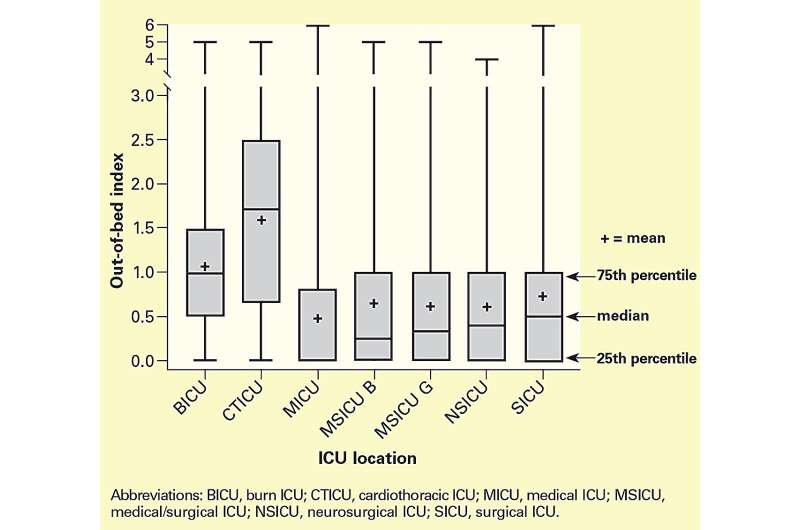This article has been reviewed according to Science X's editorial process and policies. Editors have highlighted the following attributes while ensuring the content's credibility:
fact-checked
proofread
Mobility may have dose-response relationship with ICU patient outcomes

More out-of-bed mobility interventions for critically ill patients were associated with shorter mechanical ventilation duration and hospital stays, suggesting a dose-response relationship between daily mobility and patient outcomes, according to a study published in the American Journal of Critical Care.
"Early Mobility Index and Patient Outcomes: A Retrospective Study in Multiple Intensive Care Units" examined mobility practices and patient outcomes across seven adult intensive care units (ICUs) at UC Davis Medical Center, part of the University of California Davis in Sacramento. The analysis looked at electronic health record (EHR) data from 8,609 adult patients hospitalized for at least 24 hours from December 2015 through October 2018.
Overall, the retrospective study found that each additional out-of-bed event performed per mobility-eligible day conferred a 10% decrease in mechanical ventilation, a 4% increase in ICU length of stay and a 5% decrease in total hospital length of stay.
Co-author Sarina Fazio, Ph.D., RN, is a clinical nurse scientist in the UC Davis Center for Nursing Science.
"Our findings support a dose-response relationship between mobility and specific patient outcomes," she said. "Associations differed across ICU patient populations, raising important questions as to how frequently, how intensively and for how long therapy should be provided for people in different units."
The research team developed a rules-based algorithm using EHR-derived fields to count the number of out-of-bed mobility events that patients in the ICUs completed, such as sitting at the edge of the bed or in a chair, standing at the bedside, marching in place or walking.
Mobility-eligible days were defined as ICU days on which various safety considerations and specific contraindications were not present.
Using the data, the researchers defined a mobility dose, called the OOB-E index, for the full cohort and a separate one, the OOB-E before extubation index, for those patients who received mechanical ventilation. The index is calculated as the number of out-of-bed mobility events on eligible days divided by the number of mobility-eligible ICU days.
Nearly 70% of patients (n=5,957) had at least one out-of-bed mobility event while in the ICU, and patients were mobilized out of bed on 46.5% of ICU days.
The median OOB-E index was 0.5 (0 to 1.2) events per day among all adults hospitalized in the ICUs. The index was higher in ICUs that were predominantly surgical ICUs (cardiothoracic, neurosurgical, surgical and burn ICUs) than in medical and mixed medical/surgical ICUs, primarily because of daily mobility interventions in the cardiothoracic and burn ICUs.
Of the 3,443 patients who received mechanical ventilation, 569 (16.6%) achieved an out-of-bed mobility event during mechanical ventilation.
More information: Sarina A. Fazio et al, Early Mobility Index and Patient Outcomes: A Retrospective Study in Multiple Intensive Care Units, American Journal of Critical Care (2024). DOI: 10.4037/ajcc2024747




















